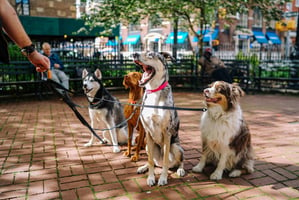Training your dog to roll over is a fun, rewarding activity that can be shared between you and your...
How to teach your dog to roll over.
When teaching your dog to roll over, it is important to have a few other fundamental commands in place first.
The basic commands your dog should know, are a few simple obedience related terms that are not only good for your pooch to learn, but will also save you from many varying disasters in the future. If you are wondering when to start teaching your puppy the basic commands, check out our article on the best time to start training a puppy on Fluffy.
-
Sit. This command is one of the easiest to teach and is usually the first command introduced to a dog or puppy. Learning this command also helps the dog learn how to respond to training.
-
Down. Another practical command is down (lay down). This is great for all dogs, but especially for large dogs.
-
Stay: The “stay” command comes in handy when you need your pup to stay put while you go to answer the door or sit down to wrap holiday gifts.
-
Come: considered one of the most essential of commands. The “come” command protects him or her from traffic, neighbours, and encounters with other dogs.
-
Off: This command is preferred to teach your dog that jumping on people or climbing on the furniture is inappropriate.
-
Don’t Touch: Teach them to let go of found treasures when you say “don’t touch” or “leave it.”
-
Heel: There are many different training strategies you can use to teach your dog to heel aka walk by your side and to stop and sit when you stop moving.
Once you have these commands mastered, your pooch will have a better understanding of what you want and it will make all other teachings a much easier task.
Is it easy to teach my dog to roll over?
Roll over is a relatively easy trick to teach your dog once they have the basic commands down pat. Each trick and how easy it is to teach will always vary for each individual dog and trainer. Keep reading below to see just how simple the steps are for teaching your dog to roll over.
Teaching your dog to roll over with positive reinforcement
We talked about Dog Tricks to Teach Your Dog, in one of our previous articles and explained how positive reinforcement has been proven to be very effective and is the most popular and widely recommended method for teaching dog cues and behaviors.
Positive reinforcement involves only rewarding the behavior you like and simply ignoring unwanted behaviors.
How hard is it to teach a dog to roll over?
Teaching your dog to roll over can be a little more difficult than other single action commands like “sit” or “down”. However, if you ensure that your dog already has the basic commands down pat, teaching them to roll over will be a lot easier. With a little patience, your dog will be rolling over before you know it.
How long does it take to teach a dog to roll over?
How long it takes to teach your dog to roll over is dependent on a few different factors such as each individual dog learns at their own pace and some will take longer than others.
How much time, patience and effort you put into training them is a contributing factor too – if you don’t have much time, then it will of course take longer than someone that can spend the time teaching several sessions of how to roll over every day.
What do you need before teaching your dog to roll over?
Step 1: Ensure that you have some treats on hand to reward your pup when they do the right thing or take a step in the correct direction. Have something on hand that would be considered their favourite treat and have whatever it is, available in small bite / gulp sized pieces.
Step 2: Make sure your dog responds to the “down” or “lay down” command is the first step in teaching them to roll over, as they have to be in this position in the first place before being able to do the roll.
Step 3: Have a designated training space, it could be a certain area or a specific room and make it a fun and safe place for your dog to learn.
How to teach your dog to roll over in 5 simple steps
Step 1: Start out teaching your dog to roll over by giving the command for your dog to “lie down”. Once your dog is in the lying position, rolling over will be an easy next step without putting too much strain on your pooch.
Step 2: Use a treat you can place in front of the dogs’ nose, begin by moving the treat back towards his shoulder, by your dog following the treat this way, it should make them lay down on their side. When this is accomplished, reward and praise them. Continue to do this until they are comfortable with laying down on their side.
You may find that your dog favours lay on one side as opposed to the other, for the purpose of starting out, don’t be afraid to continue teaching on this side until they get the hang of it.
Step 3: Now that you have your pups attention and you have mastered asking them to lay on their side, get another treat and slowly move it towards their back bone. You ever treat loving pooch should follow the treat with their nose, and where the nose goes, the body follows.
This should cause him to roll completely over, so when they do this, reward and praise them again, make a huge fuss and ensure that this is a fun activity for your dog at all times.
Continue to follow this process in teaching your dog to roll over and include your desired cue when asking him to do so. You may prefer hand signals, clicker training or verbal cues, or you may choose to use a verbal cue alongside a hand signal, so go with what works for you.
Step 4: Phase out the treats and replace them with a lot of fuss and cuddles once your dog is rolling over like a master on cue. Spread out the time between offering treats as a reward for completing the trick. You don’t want your dog to expect a trick every time they complete a trick. After all, we don’t want to be treating our dogs to the point where they develop a weight-related issue.
Step 5: Take your trick to the next level and your pooch out of his comfort zone. Try taking your dog to a new spot to complete the trick, this offers something new, different distractions and will test their concentration levels.
Once you can take your dog to several different areas and maintain their full attention in completing the trick, ask some friends or family to be your audience and complete the trick for them too. Your dog will absolutely love the attention.



